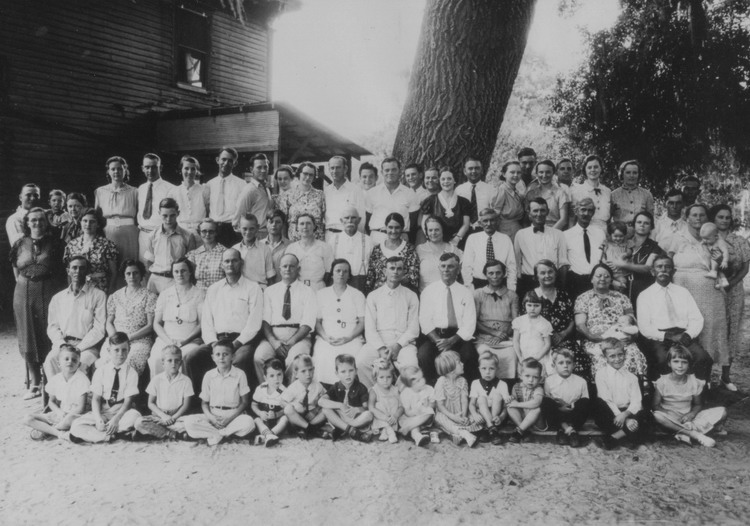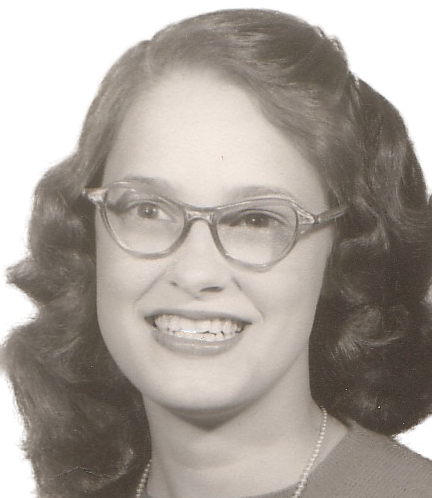

1937
Family Gathering

Wilbur Mixson 2nd row with Rosalie
standing behind him, Morris Mixson, Arnold Mixson and their cousin
James Mixson 1st row.
(See 1937 Reunion
for completed list)
In the summer of 1937, around seventy of the Mixson and Feaster families in the Flemington and Shiloh areas gathered for a reunion on the old Feaster farm. The Mixson and Feaster families were connected in 1901 when Mary Telula Mixson, the oldest daughter of James Darlington Mixson’s twelve children, married Jacob Wesley Feaster. It was a productive union with Mary and Jacob having seven children which, in 1937, six were married into Dixons, Tilmans, Browns and other families.
A gathering of southern families would not be complete without a diner which was held under the magnificent two-hundred-year-old oak tree that stood in the yard of the Feaster home. Long tables were setup, made from sawhorses with boards on top, covered with beautiful hand embroidered tablecloths made by the women with the food placed on top. And food there was, with each family bringing their own special dishes and deserts, there was corn on the cob, corn pudding, fried okra, black eye peas, turnip and collard greens, mashed potatoes, scallop potatoes, tomatoes, squash, cucumbers, salads, and a few dishes that no one were sure what they were. There was fresh baked homemade rolls and cornbread, fried chicken, baked chicken, roast beef, and fried catfish. Onnie Lee even made her famous hog liver pudding. The deserts were a delight to see with cakes and pies of every kind, cookies, puddings, and sweet breads. All was placed on the table grouped by salads, vegetables, and then meats. The table was over twenty feet long, loaded with food end to end.
Being told a group picture would be taken, everyone came dressed in their Sunday church clothes. Just after noon, with the food on the table, an announcement was made to gather under the tree for the photo, knowing that everyone would do so wanting to eat while they would never be able to get them to gather after eating. Rows were made, children in front, fifteen across, then parents in three rows behind them, with mothers holding infants. After some arranging and shuffling people around by the photographer, everyone could be seen, and the photo was taken. After the photo and Jacob Feaster saying the blessing there was some discussion about who should go first, the old, the young, the mothers with children and so forth and lines were formed on both sides of the food table. There were no paper plates at that time so you would pick up a real plate and progress down the line putting a piece of this, a spoonful of that on your plate. It was a difficult task for you did not want to overload your plate to early and not be able to put something better that was further down the table, and you didn’t want to miss out on someone’s well liked or talked about dish. Getting to the end of the line you think you might have to come back for the things you missed, hoping there would be some left. There was even ice for the sweet tea which was special since no one had refrigerators at that time, someone had gone to the Icehouse in Williston that made ice for the produce that the farmers sold then shipped out on the train.
After loading your plate, you would find a place to sit, some tables were set up for the parents while the kids took their plates off to sit on the grass or on the steps of the house. After finishing your plate, you might want to go back for seconds, hoping that that dish you missed would still have some left. Then there were the deserts, the children all being told they could not have desert until they finished their plate, ate the quickest and were first in line choosing a cookie, piece of cake, a piece of pie or perhaps all three.
After eating, some the younger men and boys formed into two teams and played a game of softball in the large front yard of the house. The occasional clink, clink sound could be heard from a game of horseshoes some of the men had started up. The women, after cleaning up, sat about visiting and talking to each other. Some of the older boys took their shotguns and setup a target to shoot at while the young girls talked about mostly about the boys. As the afternoon wore on the activities wound down and people wandered back to the food table getting a late afternoon snack before visiting with folk they hadn’t yet talked to. With the sun low, one family after another trickled away saying their goodbyes, or “I’ll see y’all at church” before getting into their trucks and cars and going home. With the sun setting only the closest family remained, three generations of Feasters, the grandparents, Mary Telula and Jacob, their children and their spouses and the grandchildren, all staying the night in the big two-story house.
Since 1937 the reunions have been held most years under the same old oak tree, only being canceled a few years for various reasons including 2020 and 2021 due to COVID-19. Each reunion the group recognizes members of that attended the 1937 photo with their number growing smaller each year. In 2018 there were only ten remaining members including my father who was 92 at the time. Since then, John Alvin Dixon, Anita Dixon Beck and my father have passed leaving only seven. (In 2021)

Betty Dixon Yawn, Morris Mixson (died 2020), Jimmy Mixson, J. L.
Feaster, Wesley Dixon Glen Feaster, John Alvin Dixon (died 2018)
Charles Filmer, Richard Feaster, Anita Dixon Beck (died 2020)
On December 30, 1937 Fred and Wavie Junior’s fourth daughter was born in Grand Rapids Michigan who they named Carole Lynn Junior.
Updated: 10-22-2021
